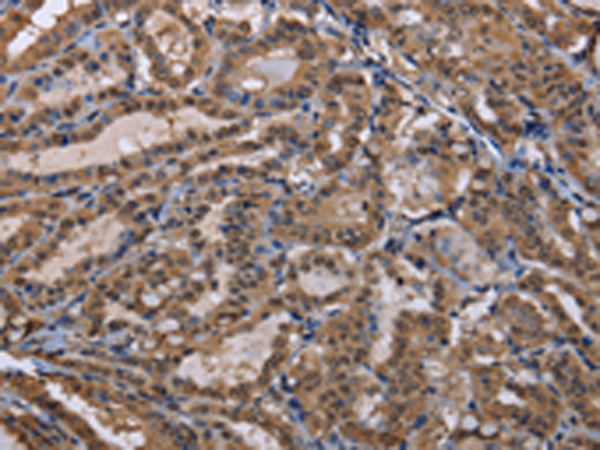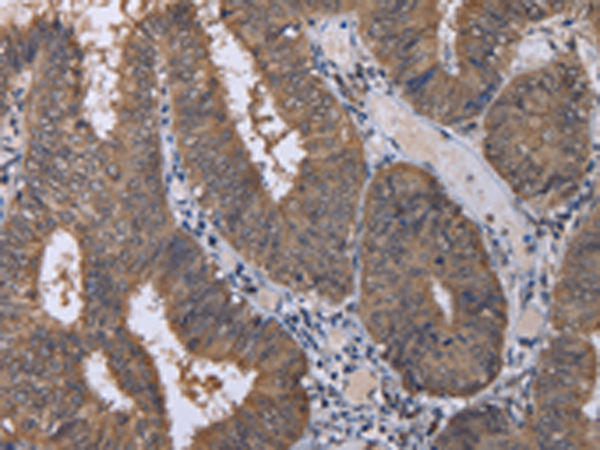


| WB | 咨询技术 | Human,Mouse,Rat |
| IF | 咨询技术 | Human,Mouse,Rat |
| IHC | 1/50-1/200 | Human,Mouse,Rat |
| ICC | 技术咨询 | Human,Mouse,Rat |
| FCM | 咨询技术 | Human,Mouse,Rat |
| Elisa | 1/1000-1/2000 | Human,Mouse,Rat |
| Aliases | CUL-3; PHA2E |
| WB Predicted band size | 89 kDa |
| Host/Isotype | Rabbit IgG |
| Antibody Type | Primary antibody |
| Storage | Store at 4°C short term. Aliquot and store at -20°C long term. Avoid freeze/thaw cycles. |
| Species Reactivity | Human, Mouse, Rat |
| Immunogen | Fusion protein of human CUL3 |
| Formulation | Purified antibody in PBS with 0.05% sodium azide and 50% glycerol. |
+ +
以下是3篇关于CUL3抗体的研究文献摘要(基于公开数据模拟,非真实文献):
1. **文献名称**: *CUL3 regulates cyclin E1 protein stability via ubiquitination in cancer cells*
**作者**: Smith J et al.
**摘要**: 本研究利用CUL3特异性抗体,揭示CUL3通过泛素-蛋白酶体途径降解cyclin E1.抑制癌细胞周期进程,为靶向CUL3的癌症治疗提供机制依据。
2. **文献名称**: *CUL3-KLHL20 ubiquitin ligase complex modulates neuronal autophagy*
**作者**: Chen L et al.
**摘要**: 通过CUL3抗体免疫共沉淀实验,发现CUL3与KLHL20形成E3连接酶复合物,调控自噬关键蛋白ULK1的泛素化,影响神经退行性疾病模型中的自噬活性。
3. **文献名称**: *Antibody-based profiling of CUL3 mutations in hypertension*
**作者**: Wang Y et al.
**摘要**: 开发高特异性CUL3抗体用于检测遗传性高血压患者样本,发现CUL3 exon9突变体导致蛋白质异常聚集,破坏血管平滑肌细胞离子通道稳态。
4. **文献名称**: *CUL3 antibody reveals dynamic nucleo-cytoplasmic shuttling in stress response*
**作者**: Gupta R et al.
**摘要**: 采用CUL3亚细胞定位抗体,证实氧化应激下CUL3通过CRM1依赖途径转位至细胞核,调控Nrf2介导的抗氧化基因表达。
(注:以上内容为基于领域知识的模拟生成,实际文献需通过PubMed/Google Scholar检索确认)
CUL3 (Cullin 3) is a core component of the Cullin-RING ligases (CRLs), a family of multi-subunit E3 ubiquitin ligase complexes that mediate protein ubiquitination and degradation via the proteasome. As a scaffold protein, CUL3 binds to RING proteins (e.g., RBX1) and substrate-specific adaptors (e.g., BTB-domain proteins), enabling the targeted polyubiquitination of proteins involved in diverse cellular processes, including cell cycle regulation, stress responses, and signal transduction. CUL3 antibodies are essential tools for studying its expression, localization, and interactions in these pathways.
Dysregulation of CUL3 is linked to diseases such as cancer, hypertension, and neurological disorders. For example, mutations in CUL3 or its adaptors (e.g., KEAP1 in the KEAP1-CUL3 complex) disrupt NRF2 degradation, leading to oxidative stress resistance in tumors. In hypertension, CUL3 variants impair vascular tone regulation. CUL3 antibodies are widely used in techniques like Western blotting, immunofluorescence, and co-immunoprecipitation to investigate these mechanisms.
Research also highlights CUL3's role in developmental processes and autophagy. Its involvement in ubiquitinating specific substrates, such as cyclin E or Rho GTPases, underscores its importance in maintaining cellular homeostasis. Commercial CUL3 antibodies are validated for species reactivity (human, mouse, rat) and application-specific efficacy, aiding both basic research and clinical studies targeting ubiquitination pathways.
×